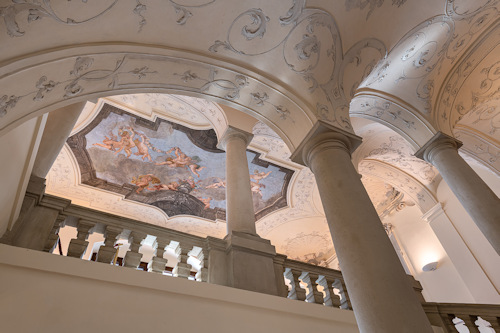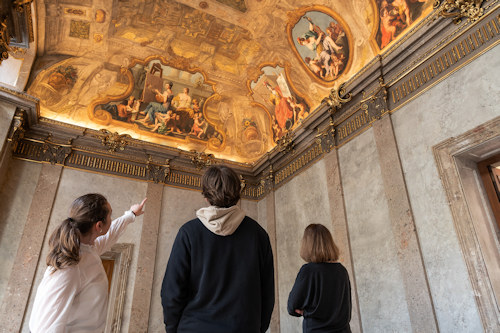
Right in the heart of Vienna stands a 17th-century palatial townhouse. But the broad front of Palais Lobkowitz offers no hint to its famous musical connection (if you discount the trumpet on the martial door reliefs).
- Open to the public as it houses the Theatermuseum
- Beethoven performed here regularly
- Home to the Eroica Saal, where Beethoven’s 3rd symphony premiered
- Book a concert experience* for Vienna
- See also:
Baroque beauty

(Behind is the spire of the Augustinerkirche church)
Given the incredibly central location, you can assume the land cost the first owner something more than a pair of chickens and a bushel of wheat to purchase.
Having said that, Palais Lobkowitz actually began life on rather insalubrious ground: the site once hosted a pig market. From pork to palais…
Today’s rather fine-looking building went up in the late 1600s under the guidance of architect, Giovanni Pietro Tencalla, who also worked on part of the Habsburg’s Hofburg complex.
The palais name comes from the aristocratic Lobkowitz family, who bought the building in 1745 and remained owners for well over 200 years. The property passed through various architectural eras and trends more or less intact and now belongs to the state.

(The palais vestibule; press photo © KHM-Museumsverband)
The preserved Baroque architecture makes it quite a rare beast in Vienna, where the assembled rich of the empire often flaunted their wealth through rebuilding works and new constructions.
Although Palais Lobkowitz lacks the spectacular decoration of many of its city-centre neighbours, it does have two rather important claims to fame.
First, the building now houses the national Theatermuseum museum of theatre, which means a visit to that museum comes with the bonus of a look around the insides of the palais (the kind of residence that has a fountain inside the entrance).
Indeed, the museum now offers an upgrade to the usual entrance ticket: a 10-stop Palais Lobkowitz audio guide tour with details on the history and architecture of the building.

(The front entrance to the palais)
Second, a certain composer used to pass through the doors regularly to entertain the owners with a fresh piece of music…
The Beethoven connection
A couple of centuries ago, it seems making a decent living from music was as tough as it is today. Which is why a fair few famous composers had positions at aristocratic courts or relied on the support of wealthy sponsors.
Beethoven was no different. And one of his main sponsors during his long stay in Vienna was a certain count named Franz Joseph Maximilian von Lobkowitz (1772 – 1816).
Being a sponsor came with a few perks, of course.
For example, Beethoven dedicated his third, fifth and sixth symphonies to the count and would have been no stranger to the nobleman’s home.

(Site of the first performances of Beethoven’s 3rd and 4th symphonies: the Eroica Saal; press photo © KHM-Museumsverband)
That third symphony (the Eroica symphony) was first performed privately in Palais Lobkowitz in 1804, with Beethoven as conductor.
The first public performance took place at the Theater an der Wien on April 7th, 1805. New works by Franz Clement also shared the bill that day, along with, for example, excerpts from Luigi Cherubini’s opera Anacréon.
A ticket to the Theatermuseum (or the audio guide tour) allows you to visit the small venue that hosted the private Eroica premiere and one for Beethoven’s fourth symphony.
This Eroica Saal feels smaller than you might expect, but the musical significance seems to echo down the decades: you have to fight the urge to sing loudly just to see what it sounds like.
Frescoes from the 1720s cover the entire ceiling, each painting representing an aspect of intellectual endeavour at Vienna’s Academy of Fine Arts (still going strong today). So you might spot such disciplines as music, painting, landscape gardening, engineering, and similar.
The painter (Jacob van Schuppen) clearly “admired” the female form, many of whom seemingly felt unable to write poetry or undertake urban planning without first exposing their ample breasts. Sigh.
How to get to the Palais
If you’ve been enjoying a Dürer at the Albertina Museum, eating cake at Café Mozart, or wandering through the Hofburg, then you’re pretty much already there.
On the subway, take the U1 or U3 to Stephansplatz or the U1, U2 or U4 to Karlsplatz. Any tram stopping at Oper/Karlsplatz gets you close (1, 2, D, 62, 71 lines).
And the little buses that wend their way gingerly through the centre stop nearby. Take the 2A to the Albertinaplatz or Plankengasse stops.
Address: Lobkowitzplatz 2, 1010 Vienna